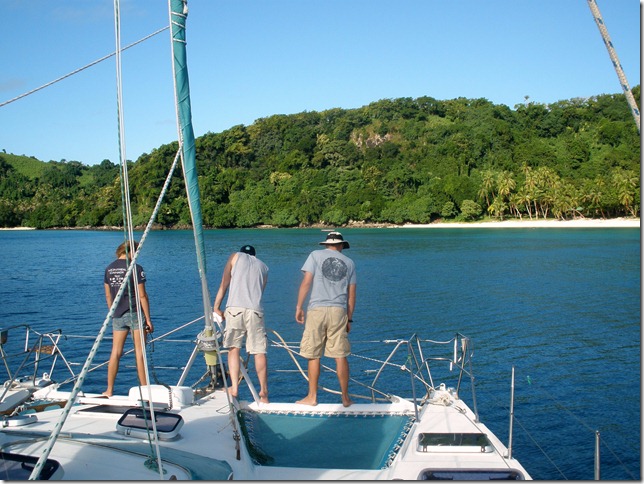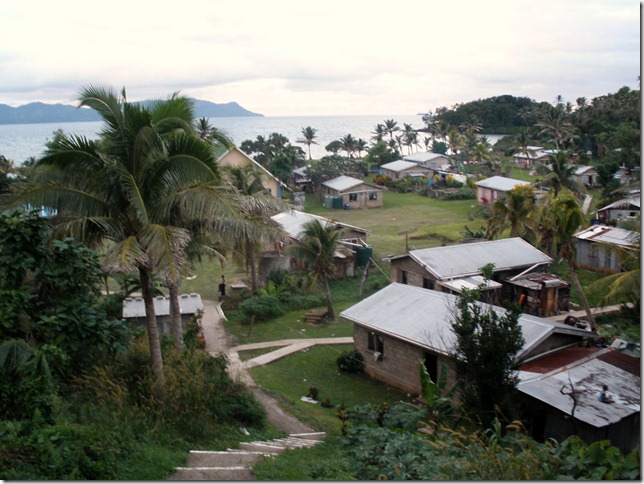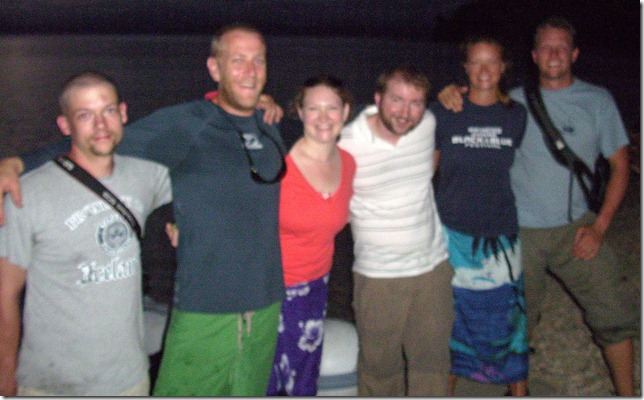Aside from the dirty water and long paddle to the Yacht Club, Suva was really not bad for a city of 200,000 or so. There aren’t many tall buildings and the downtown area, which has most everything you need can be walked easily. Taxis are plentiful and cheap, as is good Indian and Fijian food. Nearly half of the population of Fijian is Indian. The Indians were originally brought by the British as indentured servants to work the sugarcane plantations and are now a large percentage of the population in the urban areas and very active in commerce. The city center is a colorful, busy place.
Even for a big city, the Fijian people have been incredibly friendly. While Shiroma and I were making the rounds downtown to get her released as crew from Pura Vida, we stopped to have lunch in the large and bustling market. We bought a couple of samosas and sat at a picnic table beside in between two of the small stalls. Unlike the US, where it’s very rare to share a table with someone you don’t know, we were almost immediately joined by two Fijian men. One was an older man who was eating a homemade local dish that was the fruit of some sort of tree that was then ground and apparently mixed with water to make is a sort of very moist and dense semi-sweet cake-like substance that was wrapped in leaves. He saw us looking at it and broke off large pieces for us supplement our lunch. The second man was younger and broke off a piece of his lunch, which was like a hard semi-sweet cake covered with a firm custard and also gave us some to eat. He spoke even less English that the older man, but both were so obviously friendly with complete strangers that it was hard to feel like we were in the middle of the largest city in Fiji. The price of food also adds to the appeal — I had breakfast for $0.45 US, pre-packaged lunches in the market are $1 US, and a big lunch that often feeds two with a drink at an Indian restaurant was just over $5 US.
But, after a week we were ready to get out to the islands, so with our new crew of 6 we stowed the dinghy, extracted the anchor from the disgusting black gunk at the bottom of Suva harbor, and motored out past the hurricane shipwrecks and confiscated Asian fishing vessels that litter Suva harbor. During our stay, it had rained every day except our arrival day and the wiring between the GPS and chartplotter had gotten wet enough that the GPS wasn’t talking to the chartplotter (another to-do list item), leaving us to make our exit through the reef using visual piloting, which went well and we were soon on our way to Yanuca.
Yanuca and Beqa are the small and large inhabited islands of a giant lagoon formed by the caldera of an ancient volcano. They’re also home to Fiji’s firewalkers and some of the best soft coral dives in the world. The northwest portion of the lagoon provides nutrients from the ocean currents while at the same time limiting the wave damage so that the coral can thrive. As we sailed around the south tip of Yanuca, we spotted what seemed to be a giant piece or wood or bunch of floating seaweed off to port. A closer look through the binoculars confirmed that it was a giant brown turtle maybe 6 feet across with a massive head that popped up occasionally. Both the color and size are unique and it turns out that we saw a leatherback turtle, one of the three species present in Fiji and on the world’s endangered species list.
We dropped anchor on the west side of Yanuca in 25 feet of crystal clear water. It’s been warm and humid, and almost everyone was in the water for a swim while the dinghy was prepared for going ashore. The first beach we tried was home to a surf resort run by an America woman who hasn’t been off the tiny island in more than a year. Surf resorts are pretty common in this part of Fiji. In some cases a particularly good and famous break will be owned by the adjacent resort and only surfers staying at the pricey resort are allowed to surf it. In the case of Yanuca, the break was on a reef near a pass well offshore, so a boat from the island would take the surfers out for the morning or afternoon and then pick them up later.
Our mission ashore was to present sevusevu ashore was to present sevusevu to the chief, so we headed back to the dinghy and paddled over to the next beach where a woman was sitting on the ground with four children playing nearby. We explained our mission and she instructed one of the small boys to show us the path across the island to the village. As large fruit bats flew overhead, we tramped through the bush across the small island until we reached the village on the other side. Each time you go to a new Fijian island or island group in the more remote places, you’re required to go present sevusevu to the chief. Sevusevu is comprised of a gift of dried kava root (about half a kilo for $15 Fijian from the market) and a ceremony. Basically, someone from the village meets you and takes you to the chief’s home where the ceremony is performed. In our case, we were befriended by one of the teachers at the local school who took us on a slow walk through the village to the chief’s house. All walks through the village are slow in Fiji. They start by removing any hats and carrying any bags or backpacks in your hand instead of over your shoulder. As you walk through the village, there are many exchanges of "Bula!" (hello/health) with playing children, people barely visible inside of their houses, and passers by on the path through the village.
Once we arrived at the chief’s house, he welcomed us in and invited us to sit in the traditional circle on woven pandanus mats. I sat to the left of the chief and the teacher sat to my left. At that point, the ceremony started and I did as I’d read and handed the bundle of kava to the teacher. He then said a piece in the local language that introduced us to the chief and then placed the gift of kava in front of the chief. The chief picked it up, sat it down, then picked it up with his right hand and tapped it into his open right hand, all the while sort of bending over and partially straightening and saying what seemed like a familiar and almost formal pronouncement that included the word sevusevu a couple of times. He then put the kava back on the mat and that was the end of it. We were now free to make ourselves guests of the island and the water that surrounded it.
The teacher asked if we’d like to have a kava ceremony as well, and as most of us had never tried it, we were certainly interested. The dried kava is pounded manually into a powder and the teacher pulled a bag of the powder out as well as a slightly porous bag, a large bowl, and a couple of small bowls. The powder went into the porous bag, water was poured into the large bowl, and then in went the bag, where it was washed around sort of like it was being washed, and turned the water brown. He tasted it once or twice, declared it to be excellent, but too strong, added more water, and mixed some more. Finally, he was happy with the potency and we got down to business. First, there were the clapping instructions. The recipient of the small bowl must clap once before receiving it. While he is drinking, everyone else in the circle claps three times in unison. When he’s done drinking, he must clap three times and then the others clap a bit. Next, he needed to inquire about drink sizes — the options were low tide, high tide, and tsunami. He asked with a bit of good natured bravado, so I figured I’d better man up and go for the tsunami. He did a little talking, clapping, and arm waving over the kava bowl then filled one of the small bowls and handed it to me to be the first to drink. When I saw the bowl full of muddy-looking water I had second thoughts about my order, but I did my pre-drink clap and then proceeded to drink it all down at one go as the rules of kava drinking dictate. The taste actually wasn’t too bad, but you wouldn’t confuse it with Kool-Aid. The effects are primarily a numbing of the tongue, though if you drink enough it’s supposed to be fairly stupefying. I returned the bowl, did three hearty claps, and then the process was repeated around the circle.
We took a break in between each of the three rounds that were required to drain the large bowl and chatted. This mostly consisted of us asking questions about what we were permitted to do and about the history and nature of the village and them answering our questions and telling us about the area. There are about 200 people in the village, and their generator broke about a year and a half ago. Some of the people have small personal generators as does the chief. He turns his on at night and invites villagers over to watch DVDs. Even though electricity is in short supply, there’s a cell phone tower at the center of the island and cell phones are common. The government system in the village is fairly simple. The chief is chief by birthright, but the headman is elected by the village. The headman seems to be more relevant in matters related to the national government, but the chief is the soft spoken head authority of the village. They told us firewalking was a gift by the gods long ago and offered a show for us — $50 US each to watch, free to give it a shot yourself. We decided to pass, but it was interesting to listen to. The houses are simple affairs. Some are cinder block and others are corrugated tin over a wood frame. Windows are plentiful and are either open or have venetian-blind style glass or plastic. Doors are either absent or open. In general, the only shoes are worn on the rugby field, which is a mainstay of each village and seems to be full of the local men and boys every evening.
After another slow walk through the village with plenty of Bulas and visiting, we eventually made our way back across the island and paddled back to the boat to enjoy dinner with clear water below and a clear sky with a full moon above. It finally felt like we were back in the islands.




